Part of the process of building a Commander deck is testing that deck in a game. Sometimes, our actual game time for EDH doesn’t always lend itself to testing decks properly or thoroughly. Can 1v1 testing offer meaningful results? Let’s dig in.
Testing a Commander Deck
People love to build Commander decks. They love to theorycraft, they love to compile decklists and maybe-boards, and they love to put the cards together and sleeve them up. All too often, though, people don’t love to test their decks.
There’s a few reasons why this might be the case. It might be that the only testing opportunity is against opponents with decks that don’t jive well with what you’ve built. It might also be because you sourced a list from a friend or content creator, and trust that the list is already pretty good. Most commonly, though, it’s because people don’t have time.
Playing EDH already takes a solid time commitment. When you’re ready to play at the end of the week with your friends, it’s not a sure thing that you’ll have an opportunity to test a new brew properly. Maybe you play a game and it misfires completely; maybe your pod didn’t bring any chill decks this week; or maybe it’s a grudge match, you only have time for one or two games, and you need to pull out your favorite deck to level things after the last crushing defeat.
Either way, your new brew isn’t seeing the testing it needs. Can 1v1 testing be helpful?
1v1 Commander Testing
For those of us with busy lives and similarly busy friends, it’s not always possible to get a pod together to test a deck out. The alternatives might also be problematic — not all pods with strangers will be conducive to testing, even if there are more ways to play pickup games on Spelltable than ever before.
It’s a lot more reasonable, and realistic, to get a close friend to test the decks in a classic 1v1 game of Magic. Maybe you have a roommate who plays Magic, or a significant other who plays. Or, just one friend who is always more available than others when it comes to playing over Spelltable or MTGO.
The Pitfalls of 1v1 Testing
Of course, there are some downsides to testing a Commander deck 1v1. The first and perhaps most obvious one is that it’s not multiplayer. The limelight will always be on you and you alone. The game will be more taxing, you’ll have zero opportunity to fly under the radar, and every game piece is up for consideration when it comes to countering, destroying, or exiling cards.
This is made more apparent by the fact that there are no politics in 1v1. Your opponent will be ruthless, so setting up engines or other synergistic pieces is a lot more difficult. And as for combos? Well, all it takes is open mana to ruin your day.

Another thing that’s better balanced in multiplayer is that there’s a massive advantage to going first. Cards like Sol Ring, Cultivate, and other mana dorks are all much more powerful in 1v1 Magic, particularly if the opponent isn’t playing them. In multiplayer, it balances out due to threat assessment, but in 1v1, the resource imbalance is a big indicator of who might go on to win the game. Usually, the first player to be able to land threats or other permanents while also being able to hold interaction is the one that tends to win.
These things considered, opening hands matter a lot more. A hand that might feel fine in multiplayer — if a little slow — is potentially game-losing in a 1v1 game. If you don’t have much going on in early turns, you might fall behind pretty quickly unless you’re planning to wipe the board on turn four. And if you don’t have one of your toolbox answers for a specific problem early in the game, you might be dead in the water.
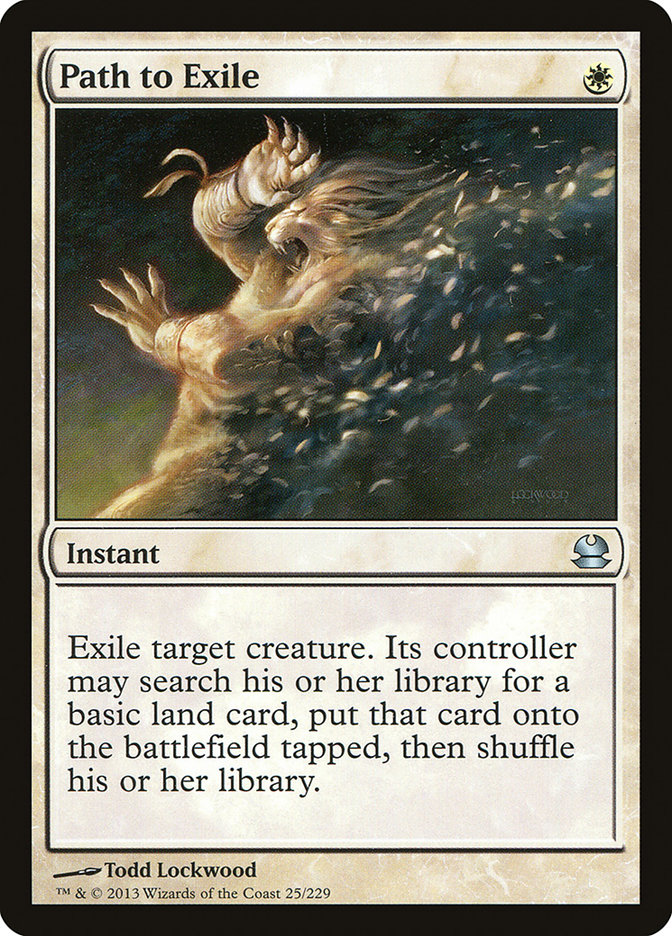
Say an opponent is running a Voltron deck with lots of protection. If you don’t have removal at the right time, the game might be over. It’s the same with graveyard hate, sacrifice outlets like Phyrexian Altar, and so on.
Because games are shorter, you won’t necessarily have time to set up or assemble a win condition, particularly if it involves a lot of moving pieces and you’re not a hard control deck. This goes doubly so if your opponent is on an aggressive deck, or if they have a game plan that you find hard to answer, as it’s so far away from what you’re doing.
All in all, this means the rock-paper-scissors effect is felt much more strongly, as certain archetypes are just more powerful in 1v1. Maybe the decks you’re jamming just don’t match at all. It’s not a sure thing that your testing partner has a deck of the right power level to match you in the first place, but even then, a deck of the right power level that just beats out another archetype most of the time will just shut another deck off of winning pretty effectively.
Ultimately, these things can make it feel like your deck isn’t performing as well as it could, or might make it feel like it’s overperforming. Both of these scenarios result in biased data, and data that might be hard to reach conclusions with, based on limited testing.
Other Things to Keep in Mind
There are some other things to keep in mind too when it comes to 1v1 testing. Firstly, the cards you’re playing might play completely differently than they would in a multiplayer environment.
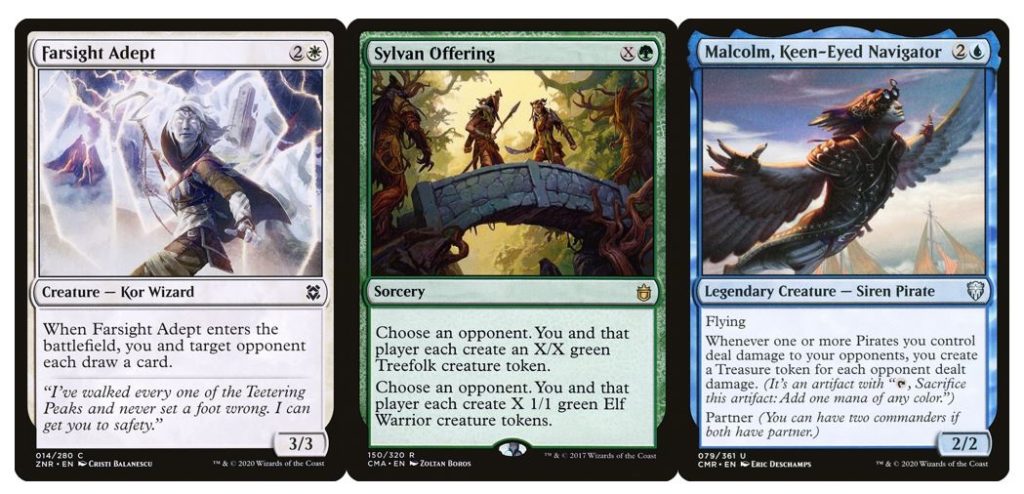
Certain cards are less effective or just bad in 1v1, particularly those that make you choose an opponent to give a resource to. Sylvan Offering will always give your opponent tokens; Farsight Adept will always give them a card; things that trigger during combat or when combat damage is dealt (like Malcolm, Keen-eyed Navigator or Akiri, Fearless Voyager) will be far less impressive.
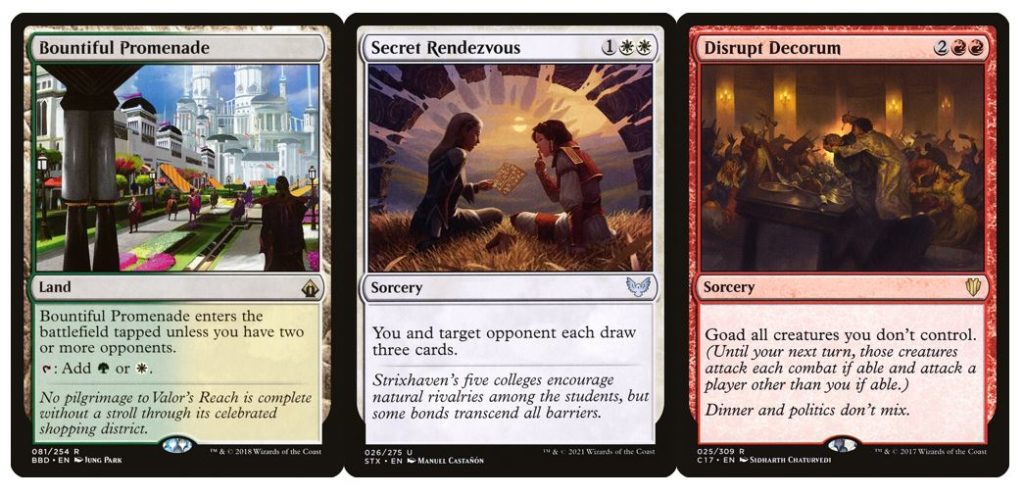
Certain cards are dead, too. The Battlebond lands will always come in tapped (unless you want to house-rule otherwise). Secret Rendezvous is really quite terrible, and Disrupt Decorum will virtually always be completely dead unless you can engineer a profitable situation — at which point you’re probably already ahead.
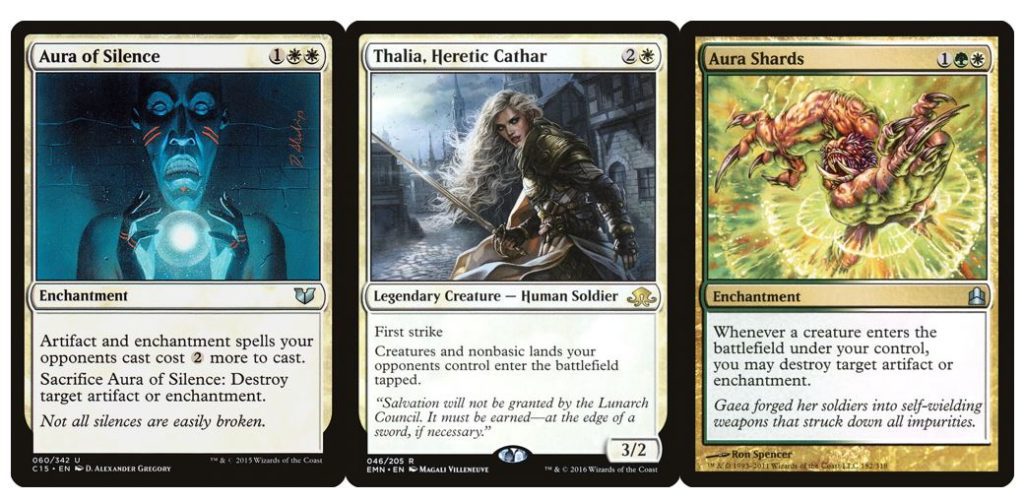
Certain effects or card types are better or worse in 1v1 depending on what your opponent is doing. An Aura of Silence on curve might stop an opponent completely, or even just slow them down enough to let you take over the game. Cards like Aura Shards will be laser-focused on stone-aging an opponent when they might ordinarily be spread out. Sometimes, the Disenchant in your hand just doesn’t matter, or the Mana Geyser that normally nets you upwards of fifteen mana might only give you seven.
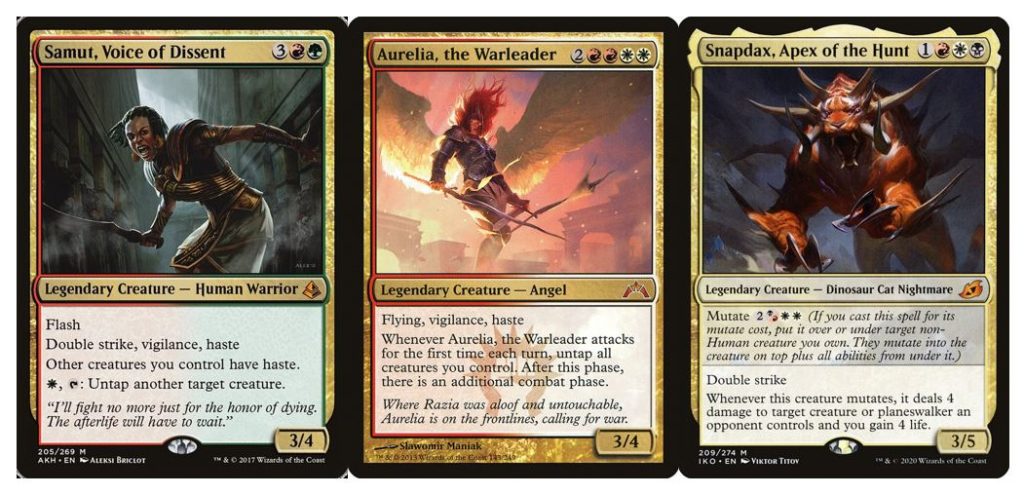
Commanders — particularly evasive beaters — can trivialize the game or otherwise take over. No matter what the game plan is, one of these creatures can just end a game out of nowhere, especially with backup protection. Even without Commander Damage, they can still end a game in short order.
Finally, it’s important to remember that 1v1 is an isolated and unique metagame. If you do make edits to your deck after testing, they could be biased toward your testing environment, which may not reflect the wider multiplayer metagame, or even that of your regular playgroup.
The Benefits of 1v1 Testing
1v1 testing might sound pretty unattractive after I’ve just laid out all of the potential issues. It’s true — it’s not perfect. But sometimes, we have to take what we can get. Getting four people together just to test a deck isn’t always feasible. The good news is that there are lots of positives of 1v1 testing, too.
First up, it’s easy to jam lots of games to get data. 1v1 games of Commander tend to be over pretty quickly, especially for more seasoned players with seasoned decks. As such, you can rack up results in no time.

Rather than just playing with yourself — or “goldfishing,” as it’s known — playing some 1v1 test games lets you get input from a friend. And let’s be honest — it’s always better playing with a friend. You’ll be able to analyze the games cooperatively, and that insight might be just what you need to discover weaknesses in your build.
The biggest bonus here is getting to the root of problems with deck performance. You can quickly identify issues with the amount of card draw, the amount of ramp, and the quantity of lands a deck runs by jamming multiple games. These key parts of how a deck performs are things you can stress test in 1v1 Magic just fine; although — like all of the benefits on the list — this isn’t as good as multiplayer testing, it can still give you the data you need.
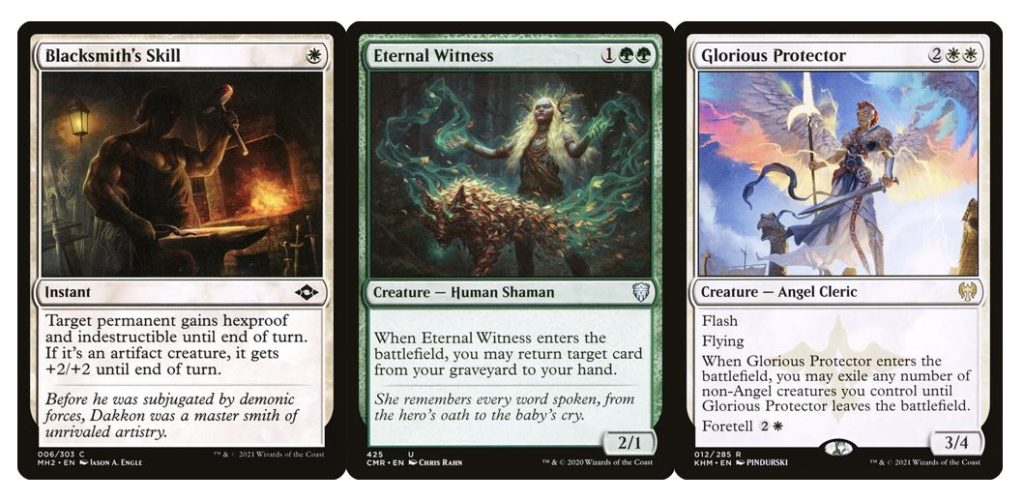
As we discussed in the “pitfalls” section, having the spotlight on you can mean you field a lot more removal than you usually would in a multiplayer game. It’s possible to turn this into an upside, though. Stress testing resiliency/recursion is easy because your deck is under a lot more pressure. You can figure out what works and what doesn’t, and whether you need more interaction or more efficient recursion.

One of my favorite aspects of testing 1v1 is being able to quickly identify what I like about a new build, and then iterate quickly on my initial draft. You can identify what you like about your first draft, and then pursue a more refined list. Oftentimes, getting down to that 100 cards is difficult, and you’ll cut out many cards that you’d actually rather play with. I like to keep a pile ready for those initial test games, ready to sub things in and out.
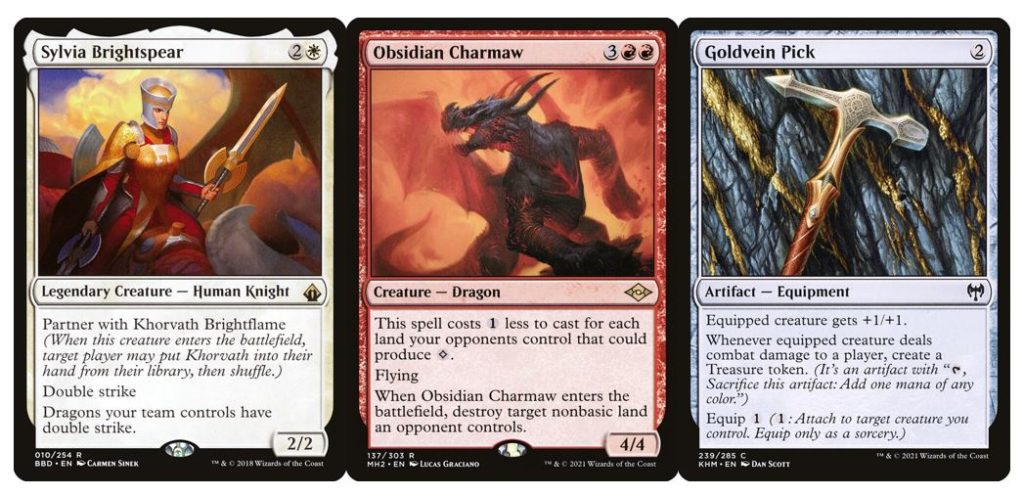
Most recently, I went through this process with Sylvia and Khorvath. I initially rebuilt the deck as Dragons and Dwarves, using changelings and Maskwood Nexus. Eventually, I realized it would be better as Dragons and Swords, changed to using only Dragons and a few other utility creatures (Magda stayed), and the deck fell together much better.
While one of the pitfalls we discussed was the inherent issues in trying to use multiplayer decks in 1v1, there is one upside to consider: you can test the deck against different kinds of deck quickly. While it might take a while to dial in a good match-up, once you do get into a rhythm, you can stress test the deck pretty well.
The biggest upside to 1v1 testing is that you can still play some casual Magic with a friend! You might not be able to get the playgroup together, and you might not have a Modern or Standard deck with you. You’ll always have a Commander deck, though, and for those times? It’s great to pull out something new that’s in a beta form. Jam some games, take some notes, and just enjoy Magic: the Gathering.
***
Hopefully, you’ve learned a little about how to avoid results-oriented thinking in today’s breakdown of 1v1 Commander testing. I’ve of course not gone over the rules for 1v1 Commander (it has a separate banlist, inherited from Magic Online), because that’s not what this article is about. Instead, I hope you’ll come away knowing how to make the most of the time you have to make your decks more enjoyable to play.
If you enjoyed this piece, let me know on Twitter. And maybe check out Canadian Highlander or Gladiator — they’re great 1v1 singleton formats that might give you a more balanced 1v1 experience when you don’t have a full crew to play with.

Kristen is Card Kingdom’s Head Writer and a member of the Commander Format Panel. Formerly a competitive Pokémon TCG grinder, she has been playing Magic since Shadows Over Innistrad, which in her opinion, was a great set to start with. When she’s not taking names with Equipment and Aggro strategies in Commander, she loves to play any form of Limited.

